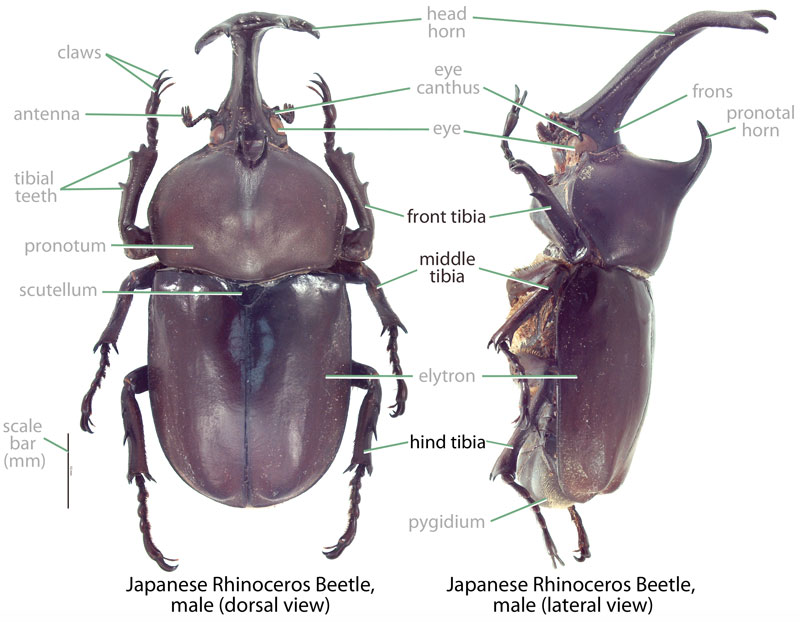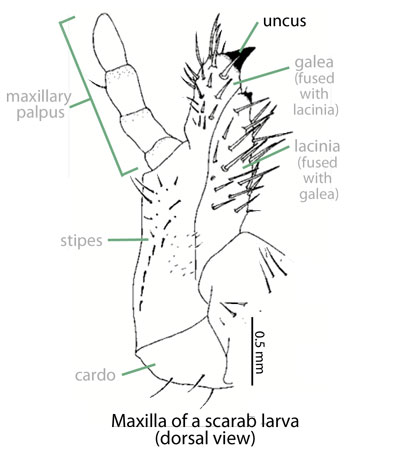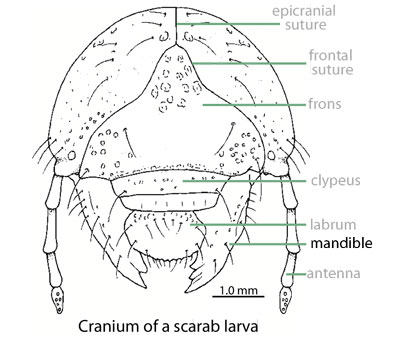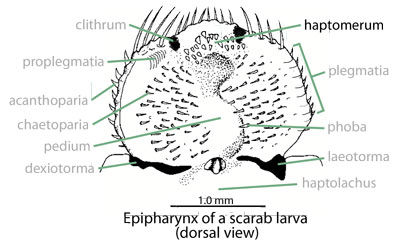Pest
oriental beetle
Family: Scarabaeidae Subfamily: Rutelinae Genus: Anomala Species: Anomala orientalis (Waterhouse, 1875)
none available
Total body length 8.0–13.0 mm (0.31–0.51 in). Body shape ovate; female often wider than male. Color tan to black; tan specimens often with black markings of variable size and position. Front tibiatibia:
a segment of the leg articulated with the tarsus and femur
 with two external teeth; apical toothtooth:
with two external teeth; apical toothtooth:
a pointed process from an appendage or margin, often in reference to the tibia
long and decurveddecurved:
bending downward
, longer in female than male; basal toothtooth:
a pointed process from an appendage or margin, often in reference to the tibia
evident in male and female. Front claw bifurcatebifurcate:
a process dividing into two points
; bifurcatebifurcate:
a process dividing into two points
claw never sinuatesinuate:
gently curved (specifically of margins or edges); often in reference to the clypeus
; female claws less robust than in male. Hind tibiatibia:
a segment of the leg articulated with the tarsus and femur
 with inner margin simple, not greatly dilated at the middle.
with inner margin simple, not greatly dilated at the middle.
(Ritcher, 1966Ritcher, 1966:
Ritcher P. 1966. White grubs and their allies: a study of North American scarabaeoid larvae. Oregon State University Monographs, Studies in Entomology 4: 1-219.): Grub C-shaped, not hump-backed, cylindrical, whitish. Maxillamaxilla:
set of paired mouthparts located posterior to the mandibles
with galeagalea:
outer branch or lobe of the maxilla
 and lacinialacinia:
and lacinialacinia:
inner portion of the maxilla entirely fused. Lacinialacinia:
entirely fused. Lacinialacinia:
inner portion of the maxilla of maxillamaxilla:
of maxillamaxilla:
set of paired mouthparts located posterior to the mandibles
with 2 unciunci:
in scarab larvae, a hooked process on the distal margin of the maxilla
 . Maxillary teeth anteriorly projecting. Dorsoexteriordorsoexterior:
. Maxillary teeth anteriorly projecting. Dorsoexteriordorsoexterior:
relating to the upper and outer part/portion
region of mandiblemandible:
The crushing or chewing portion of an insects mouthparts
 bare. Crest of labrumlabrum:
bare. Crest of labrumlabrum:
upper lip that covers the mandibles and is located ventrally relative to the clypeus
 not strongly rugoserugose:
not strongly rugoserugose:
having a wrinkled or creased texture or appearance
. Haptomerumhaptomerum:
in larvae, the medio-anterior (middle of upper) portion of the epipharynx, composed of sensory spots
 of epipharynxepipharynx:
of epipharynxepipharynx:
lobe on the interior surface of the labrum or clypeus
with a transversetransverse:
extending horizontally across a surface
row of 3 prominent unci; never with a conspicuous, transversetransverse:
extending horizontally across a surface
, curved row of stout setaesetae:
small, hair-like structure
. Last antennal segment with a single sensory spot. Posteriorposterior:
towards the rear end; opposite of anterior
frontal setaesetae:
small, hair-like structure
consisting of 2 single setaesetae:
small, hair-like structure
. Dorsa of abdominal segments 7–9 rather uniformly covered with many medium-sized setae; each bearing a caudalcaudal:
oriented towards the posterior
transverse row of 5 or 6 very long setaesetae:
small, hair-like structure
. Septulaseptula:
narrow bare area(s) of raster
oblong; palidiapalidia:
paired group(s) of recumbent (reclining) spines, usually occurring in rows; part of the raster
monostichousmonostichous:
occurring in single vertical row
, slightly diverging, each set with 11–15 palipali:
in scarab larvae, a straight, pointed spine, particularly as relates to the raster
. Anal slit slightly curved, transversetransverse:
extending horizontally across a surface
.
Uncertain. This species is probably native to either Japan or the Philippines (Reding and Klein, 2006). Because Anomala orientalis is an established, non-native pest in Korea (Choo et al., 2002Choo et al., 2002:
Choo H, Kaya H, Huh J, Lee D, Kim Hyeong H, Lee S, Choo Y, 2002. Entomopathogenic nematodes ( Steinernema spp. and Heterorhabditis bacteriophora ) and a fungus Beauveria brongniartii for biological control of the white grubs, Ectinohoplia rufipes and Exomala orientalis , in Korean golf courses. BioControl 47: 177-192. DOI: 10.1023/A:1014559729607) and the U.S. (Maine west to Ohio and south to the Carolinas) (CABI, 2015CABI, 2015:
Anonymous. 2015. Exomala orientalis (oriental beetle). Invasive Species Compendium. Wallingford, UK, CABI International. Available from http://www.cabi.org/isc/datasheet/5510 (accessed 2015).), an origin in temperate Japan may be more likely, though this remains speculation.
This scarab feeds on plants as both larvalarva:
the immature form of an insect; in scarabs, also called grub or white grub; preceded by the egg stage, followed by the pupal stage
 and adult. Adults are minor pests, sometimes causing damage to horticultural species such as Dahlia spp., hollyhock (Alcea spp.), Iris spp., Petunia spp., Phlox spp., and roses (Rosa hybrida). LarvaeLarvae:
and adult. Adults are minor pests, sometimes causing damage to horticultural species such as Dahlia spp., hollyhock (Alcea spp.), Iris spp., Petunia spp., Phlox spp., and roses (Rosa hybrida). LarvaeLarvae:
the immature form of an insect; in scarabs, also called grub or white grub; preceded by the egg stage, followed by the pupal stage
 are more serious pests, feeding on the roots of important crop and turf species including: corn (Zea mays), cranberry (Vaccinium spp.), creeping bentgrass (Agrostis stolonifera), Japanese chestnut (Castanea crenata), manila grass (Zoysia matrella), nandina (Nandina domestica), perennial ryegrass (Lolium perenne), pineapple (Ananas comosus), raspberry (Rubus spp.), reed fescue (Festuca arundinacea), smooth-stalked meadowgrass (Poa pratensis), strawberry (Fragaria × ananassa), and sugarcane (Saccharum officinarum).
are more serious pests, feeding on the roots of important crop and turf species including: corn (Zea mays), cranberry (Vaccinium spp.), creeping bentgrass (Agrostis stolonifera), Japanese chestnut (Castanea crenata), manila grass (Zoysia matrella), nandina (Nandina domestica), perennial ryegrass (Lolium perenne), pineapple (Ananas comosus), raspberry (Rubus spp.), reed fescue (Festuca arundinacea), smooth-stalked meadowgrass (Poa pratensis), strawberry (Fragaria × ananassa), and sugarcane (Saccharum officinarum).
(CABI, 2015CABI, 2015:
Anonymous. 2015. Exomala orientalis (oriental beetle). Invasive Species Compendium. Wallingford, UK, CABI International. Available from http://www.cabi.org/isc/datasheet/5510 (accessed 2015).): In New York, this species has a one year lifecycle. Adults emerge in late June and remain active until August. Adults are weak fliers and are active at night. Females deposit eggs in damp soil, with larvaelarvae:
the immature form of an insect; in scarabs, also called grub or white grub; preceded by the egg stage, followed by the pupal stage
 emerging from the eggs after 17–25 days. First instars are encountered by August, second instars by September, and final instars begin appearing by early October. Overwintering occurs in the final instarinstar:
emerging from the eggs after 17–25 days. First instars are encountered by August, second instars by September, and final instars begin appearing by early October. Overwintering occurs in the final instarinstar:
in scarabs, one of the three larval growth phases (i.e., first instar, second instar, third instar), each ending with the larvae molting to the next phase
. Feeding on plant roots, which occurs close to the surface, resumes in late March or early April.
Significant. This species is a known biosecurity threat, having a long history biological invasion. In California, Anomala orientalis is officially a species of biosecurity concern and is regarded as having a moderate risk of introduction (Cosner, 2013Cosner, 2013:
Cosner C. 2013. Invasive species pathway risk analysis for California. PhD dissertation, University of California, Davis, California. full text (accessed 2015)). LarvaeLarvae:
the immature form of an insect; in scarabs, also called grub or white grub; preceded by the egg stage, followed by the pupal stage
 are major turf pests and also attack a range of crop plants. In Hawaii, this species historically has been a major pest of sugarcane and pineapple (Pemberton, 1964Pemberton, 1964:
are major turf pests and also attack a range of crop plants. In Hawaii, this species historically has been a major pest of sugarcane and pineapple (Pemberton, 1964Pemberton, 1964:
Pemberton C. 1964. Highlights in the history of entomology in Hawaii 1778-1963. Pacific Insects 6: 689-729. full text (accessed 2015).).
Established. Anomala orientalis is known from Oahu, where it became established sometime before 1908 (Myers et al., 2003Myers et al., 2003:
Myers D, Schillinger J, Patton T, Sorensen K, Tubene S. 2003. On-farm sweet potato summer oriental beetle surveys for the development of an IPM action threshold for the prevention of juvenile white grub damage to mature roots. University of Maryland Extension, Glen Burnie, MD. Available from https://extension.umd.edu/sites/default/files/_docs/VEGWKR%20Sweet%20Potato%20Study.pdf (accessed 2015).). Interestingly while this species was once a common pest (Pemberton, 1964Pemberton, 1964:
Pemberton C. 1964. Highlights in the history of entomology in Hawaii 1778-1963. Pacific Insects 6: 689-729. full text (accessed 2015)) on the island, anecdotal evidence suggest its numbers on Oahu have declined significantly over the last several decades.
Not established or recorded. There are no records of this species from Guam.
Anomala orientalis has a long history as an invasiveinvasive:
a species that has recently arrived to a new location, usually via human activity, causing notable economic and/or ecological damage
species, having become established in Hawaii before 1908 and Connecticut (and hence the rest of the northeastern U.S.) by 1920 (Alm, 1996Alm, 1996:
Alm S. 1996. The oriental beetle. Turfgrass Trends 5 (7): 9-13.). The species should be treated as having some potential of establishing on the other islands. While the means of its arrival in Hawaii are uncertain, it was noted that the Connecticut population appears to have arrived in balled nursery stock from Japan (Alm, 1996Alm, 1996:
Alm S. 1996. The oriental beetle. Turfgrass Trends 5 (7): 9-13.). Because adults feed on many plants of horticultural importance and are easily overlooked, hitchhiking on transported garden plants likely represents a major mode of invasion. Grass sod carrying larvaelarvae:
the immature form of an insect; in scarabs, also called grub or white grub; preceded by the egg stage, followed by the pupal stage
 could also represent a potential pathway; adults attracted to lights at major shipping points such as ports and airports and subsequently stowing away on cargo could represent another.
could also represent a potential pathway; adults attracted to lights at major shipping points such as ports and airports and subsequently stowing away on cargo could represent another.
Anomala orientalis is one of five Anomala species known from Hawaii and Guam, along with Anomala cuprea, Anomala sulcatula, Anomala viridana, and Anomala albopilosa. It can be separated from the other species based upon by examination of the bifurcatebifurcate:
a process dividing into two points
male front claw (curved but non-sinuate in A. orientalis versus strongly sinuatesinuate:
gently curved (specifically of margins or edges); often in reference to the clypeus
in A. cuprea and A. viridana, weakly sinuatesinuate:
gently curved (specifically of margins or edges); often in reference to the clypeus
in A. albopilosa), the hind tibiatibia:
a segment of the leg articulated with the tarsus and femur
 of males (A. orientalis not greatly dilated at the middle on the inner margin versus inner margin greatly dilated at the middle in A. sulcatula), and body size (A. orientalis at 8.0–13.0 mm [0.31–0.51 in] versus 14.0 mm [0.55 in] or greater in the other recorded Anomala species).
of males (A. orientalis not greatly dilated at the middle on the inner margin versus inner margin greatly dilated at the middle in A. sulcatula), and body size (A. orientalis at 8.0–13.0 mm [0.31–0.51 in] versus 14.0 mm [0.55 in] or greater in the other recorded Anomala species).
Blitopertha orientalis (Waterhouse), Exomala flavipennis Reitter, Exomala orientalis (Waterhouse), Exomala tanbaensis Niijima and Kinoshita, Exomala xanthrogasta Harold, Phyllopertha orientalis Waterhouse
Report your observation of this species at our iNaturalist project.